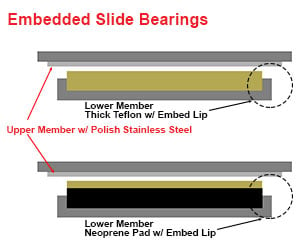We often see RFQ's and Purchase Orders for Teflon® or Fluorogold® Slide Bearing Assemblies where the configuration appears to be carried over from a previous project. Sometimes, without intending to, the plan as shown is overkill for the application at hand. In cases like this we usually give the customer the option of allowing The Steel Supply Company to engage the engineer, architect or designer to introduce alternatives. Below are some examples of common situations. As in all cases, whether they are Slide Bearings, Thermal Break Bearings or any other product line, we will only make suggestions. Changes in design should always be approved by the E.O.R.
Oversize Surface Area: Frequently quote requests are submitted showing too much surface area on the slide bearing surface. Teflon® and Fluorogold® both require minimum pressures to function correctly. The established lower limit is 70 psi, but a more efficient minimum load per square inch would be 300 lbs. Maximum psi should not exceed 2,000 lbs. So as an example, if a drawing called for an assembly with an upper member measuring 12" x 8" and a lower at 9" x 7" the assembly would need a minimum load of 4,410 lbs. to function. This is determined by the surface area of the lower surface. The upper is irrelevant in this calculation. Its size should be determined by the amount of travel the assembly needs to compensate for.
So, the lower member, at 9" x 7" = 63 sq. inches. At the very minimum of 70 psi bearing requires 4,410 lbs. to function properly. The issue with minimum load is the bearing surfaces are intended to be self-lubricating. Without the proper pressure the surface does not lubricate and hence maintains a higher co-efficient of friction, causing the assembly to wear prematurely. As mentioned above a more comfortable minimum range is 300 psi, so in the example above the load should be at least 18,900 lbs.
If the load in this case was actually 4,410 lbs. the engineer may consider decreasing the lower member to a size that would develop pressure closer to 300 psi.
4,410 lbs. ÷ 300 = 14.7 square inches
In this case, a lower Slide Bearing member 4" x 4" would distribute the load to a more efficient 275 lbs. per square inch. The upper member would also be reduced in size to mirror the lower plus the length required to allow for the maximum travel. This smaller Slide Bearing Assembly would cost considerably less and function more durably than the original one mentioned above.
 Embedded Backing Plate: As shown in the illustration the lower sliding element can be embedded or encased. This prevents deformation or horizontal creep. Advances in material manufacturing, especially with Fluorogold®, which is fiberglass infused to add strength and durability, have made encasing a typical 3/32" thick sliding surface unnecessary. So, when it is called for on drawing, we look to see two other conditions. 1) The Teflon® or Fluorogold® sliding surface is thicker than normal, say 1/4" thick. This would introduce the possibility of bulging at the sides. 2) The sliding surface is separated from the steel backing plate by a neoprene pad. This is done to absorb vibration or to allow rotation of the sliding surface, as in the case of DOT Highway Bridge Bearings. In this case the neoprene may bulge or permit lateral deformation.
Embedded Backing Plate: As shown in the illustration the lower sliding element can be embedded or encased. This prevents deformation or horizontal creep. Advances in material manufacturing, especially with Fluorogold®, which is fiberglass infused to add strength and durability, have made encasing a typical 3/32" thick sliding surface unnecessary. So, when it is called for on drawing, we look to see two other conditions. 1) The Teflon® or Fluorogold® sliding surface is thicker than normal, say 1/4" thick. This would introduce the possibility of bulging at the sides. 2) The sliding surface is separated from the steel backing plate by a neoprene pad. This is done to absorb vibration or to allow rotation of the sliding surface, as in the case of DOT Highway Bridge Bearings. In this case the neoprene may bulge or permit lateral deformation.
In both cases we would suggest the drawing be discussed with the designer. Usually when all requirements are compared with the materials available, there are less expensive and time consuming designs that can be applied that will deliver results and longevity as good or better than the original plan. Regardless of the outcome The Steel Supply Company would always manufacture these assemblies to the customers' requirements.




